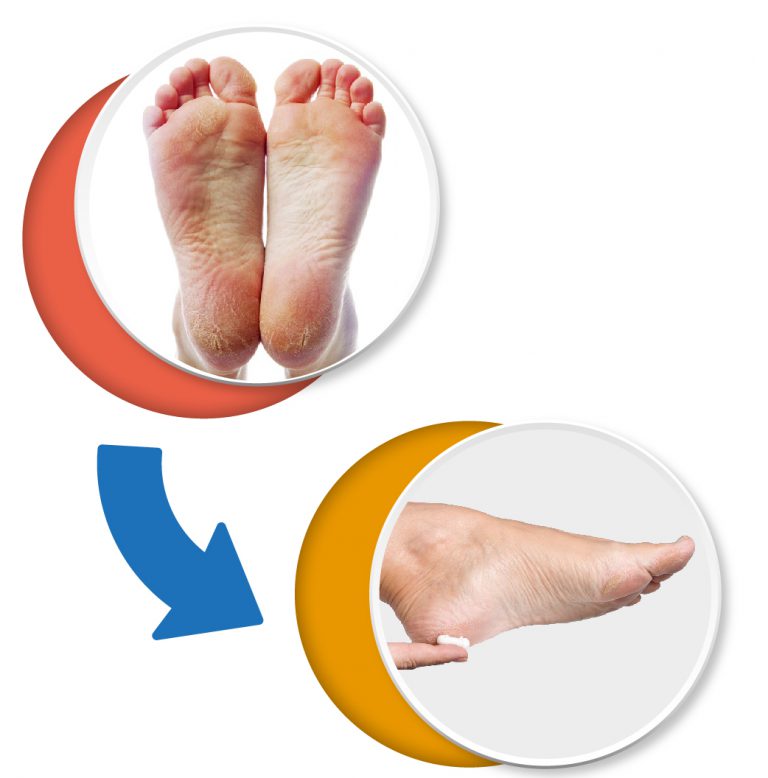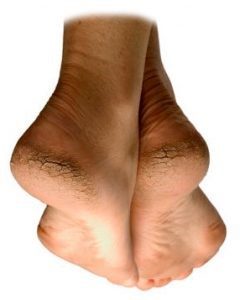Cracked Heels
Cracked heels are a common problem suffered by a large part of the population.
This is due, in the first place, to a lack of elasticity of the skin in the affected area due to a lower amount of water in our body, either due to age (as we get older, the water content of our body decreases), external factors (excessive heat and poor hydration) or a lack of sweating of our own feet that may be motivated by multiple causes (diseases such as diabetes).
This situation leads to the fact that under certain conditions our skin tissue can the tissue of our skin to break, producing these cracksproducing these cracks that can cause from an aesthetic complex to an important problem for our health and well-being.

Causes of Cracked Heels

The main symptom of cracked heelsis that the skin in this area of the foot is very dry and hard. As a result, perpendicular cracks appear, which may even bleed in the most extreme cases.
Dry feet are quite annoying and affect both men and women, even cracking the skin. This excessive dryness in the feet can appear throughout the year, which can even lead to cracked heels.
If this problem reaches the extreme situation of causing pain or bleeding, it is advisable to visit a podiatrist, who will determine the steps to follow so that the skin of the heel recovers its elasticity and hydration.
The causes of cracked heels can be very varied:
1. Lack of hydration
Sometimes we forget to take care of the skin on our feet in the same way we do with the skin on the rest of our body.
2. Some diseases or treatments
Diabetes, dialysis, chemotherapy or radiotherapy can cause the skin to dehydrate more easily, especially in sensitive areas such as the heels.
3. Wearing the wrong type of footwear
It is advisable to wear wide shoes, with good cushioning and not too high heels, to prevent the area from suffering pressure and excessive dryness.
4. Not eating a balanced diet
To have a hydrated and elastic skin it is necessary to have a balanced diet rich in all kinds of nutrients. Being overweight can also cause the heel area to suffer more pressure and dry out more easily.
5. Going barefoot
Walking barefoot causes the heel area to have much more friction with the support surface, causing dryness.
6. Very hot water and long baths
Very hot water and baths that exceed 15 minutes can cause the skin to lose its natural moisture, causing dryness.
7. Chlorine and saltpeter
In summer, bathing at the beach or in the swimming pool can cause dryness, so it is always advisable to take a shower afterwards to remove chlorine and saltpetre.
8. Tobacco
Smoking dries out the skin; as nicotine reduces blood flow and causes a lack of nutrients and oxygen in the bloodstream.
9. Drinking little water
The main way we have to hydrate ourselves is to drink water, so it is very important to consume between 1.5 and 2 liters per day. If we do not do it, it is easier for the skin to be dehydrated and dry.
Diagnosis for Cracked Heels

The most common cause, as we have mentioned, is lack of hydration, either because environmental conditions, such as exposure to extremely low or high temperatures together with inappropriate footwear, favor this dryness, or because we have this tendency naturally and it may be aggravated in these conditions.
However, there are many other factors that favor their appearance, from problems in our footprint that generate more callus and lead to the formation of cracks, diet, low consumption of omega-3 fatty acids and zinc, standing for long hours, or the effects of some medications (diuretics).
These cracks usually take several days or weeks to develop, we can observe that some changes begin to occur in our feet, such as the following:
- Red patches: They are usually ignored and this is when the problem starts to worsen, as the flaky, dry skin becomes more vulnerable to infection.
- Cracked skin, dryness and flaking: This is the next step and we will have to start taking measures to reverse this situation. You should not remove the dead skin, as it can damage the new skin underneath. Your podiatrist will help you to remove what he/she thinks is necessary for a more effective treatment.
- Itching: It is due to a decrease in the most superficial layers of the skin that causes stretching of the layers underneath.
- Bleeding or discharge: This can occur in the most severe cases if it has not been treated properly. It will be indicating that the cracks are affecting the deeper layers of the skin.
- Lesions in the form of grooves around the heel, pain and tenderness and hardening. Observed, in addition, a change of coloration towards yellow or brown in the skin of the affected area.
It is important to know that there can be several complications if we do not remedy in time; if deeper levels of the foot are affected, reaching the dermis, they usually generate significant pain, even bleeding due to the pressure it bears when walking. If we do not take care of the wound, it could become infected, which could make us unable to perform activities of our daily life that require simply standing or walking.
Treatment for Cracked Heels

In addition to being unsightly, cracked heels can cause other more important problems such as pain, bleeding or infections. Therefore, here are some treatments to solve this problem:
1. Visit a podiatrist
If dry heels cause discomfort or bleeding, it is very important to see a specialist. Deep cracks in the heels can be an entry point for microorganisms and can cause infections. The podiatrist will propose the most appropriate treatment in the most serious cases.
2. Perform a hydration cure
If you haven’t used moisturizer for a long time and the problem is very evident, a moisturizing cure may be the perfect solution for you. Apply a specific cream to the area, such as Derma Feet cracked heel cream, and cover the area with plastic wrap overnight to allow it to work.
3. Drink water and eat a balanced diet
As mentioned above, eating a balanced diet rich in all kinds of nutrients and drinking about 2 liters of water a day is essential for a hydrated and elastic skin.
4. Moisturize your feet daily
Just as we take care of the skin of our body, it is necessary to take care of the skin of our feet. It is important to use a specific cream for the feet, which has urea as its main component, as this ingredient helps to prevent water loss. Urea 20% Derma Feet foot cream will be your great ally to keep your feet moisturized. It is advisable to moisturize at night.

The ideal treatment is to start with Dermafeet cream for cracked heels, which contains 20% Urea + Salicylic Acid and then continue with a conservative treatment with Dermafeet 20% cream.
Products that can help you
Information written by Herbifeet and podiatrist: Daniel Torres Montalvo


